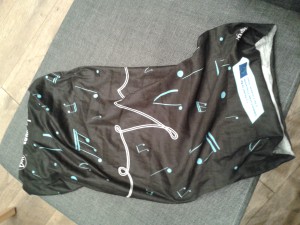 It’s not every day that an international conference starts with the national host welcoming everyone by blowing through different sized seashells and the event manager giving a comedy demonstration of a buff, showing delegates different ways in which a garment – purposely designed for the event – could be worn and used. But this is no ordinary conference. It’s the gathering of Europe Jazz Network, a pan-European group that brings together promoters, festivals, venues and national music agencies to discuss issues, opportunities, and collaborative ideas around jazz and improvised music today.
It’s not every day that an international conference starts with the national host welcoming everyone by blowing through different sized seashells and the event manager giving a comedy demonstration of a buff, showing delegates different ways in which a garment – purposely designed for the event – could be worn and used. But this is no ordinary conference. It’s the gathering of Europe Jazz Network, a pan-European group that brings together promoters, festivals, venues and national music agencies to discuss issues, opportunities, and collaborative ideas around jazz and improvised music today.
 Once the seashells performance and jazz buff demonstration were over, EJN President Ros Rigby welcomed Professor Christopher Dell to the stage to deliver a performance-based keynote speech that described an improvisational approach to urban planning, architecture and design. Interspersing examples of theory and practice with short improvisations on the vibraphone, Dell drew on the work of Henri Lefebvre to argue that cities and spaces should no longer be understood as fixed objects, and instead advocated an improvisation-led approach to architecture and urban design which encourages both a hands-on and reflexive exploration of spaces and materials.
Once the seashells performance and jazz buff demonstration were over, EJN President Ros Rigby welcomed Professor Christopher Dell to the stage to deliver a performance-based keynote speech that described an improvisational approach to urban planning, architecture and design. Interspersing examples of theory and practice with short improvisations on the vibraphone, Dell drew on the work of Henri Lefebvre to argue that cities and spaces should no longer be understood as fixed objects, and instead advocated an improvisation-led approach to architecture and urban design which encourages both a hands-on and reflexive exploration of spaces and materials.
Although not talking specifically about festivals and heritage sites, the talk resonated with the CHIME project in several ways, most notably by encouraging the audience to think about the way in which places are used and re-used and how urban environments are understood as both produced and performative spaces today. CHIME will add to this discourse about how spaces can be reconfigured, transformed and reimagined over time and will extend the focus of study to landscapes, rural settings, post-industrial sites and other heritage settings.

Following the session, I was left thinking about how the seashells performance and the comedy jazz buff demonstration also fed into the discussion about improvisation, space and design. Although certainly not planned, the seashell performance, keynote talk, and buff routine provided different examples of the same process; how material objects play a performative role in everyday life and can be used and re-used according to changing needs and community interests. Ultimately, we can understand how improvisatory acts like these can be thought of as a processeces that draw on, interact with, and adapt to a changing environment. They also encourage a sense of play and the loosening up of convention. Although my subsequent #JazzBuff Twitter posts were designed as a bit of fun for some conference delegates, they also invited people to play with objects, to use and reuse materials in the improvisatory spirit of the event.





